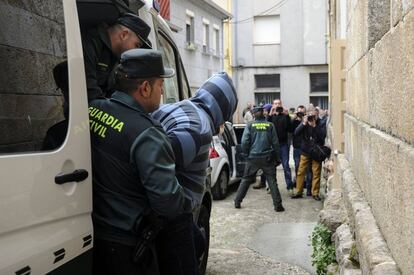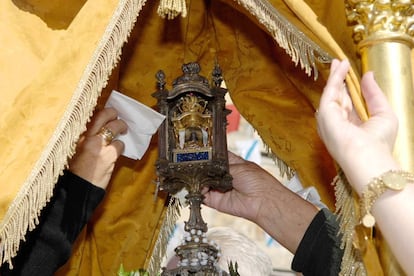The mysterious case of the dead priest and the tiny Virgin Mary
A brutal murder in a small Galician village is still shrouded in mystery despite recent arrests

“If this is the world that I created, let the devil take me.” Antonio Gómez, the new parish priest in the Galician hamlet of Vilanova dos Infantes (Celanova, Ourense), quotes the local poet Manuel Curros Enríquez, who wrote about a God looking out from behind the clouds and gazing down in deep disappointment at the humans below.
Father Antonio was friends with Adolfo Enríquez, his predecessor, who was killed at the age of 77 in a brutal homicide that took place here last March.
The body of the man who had run the local church for 45 years was covered with bruises, suggesting that he was tortured before his death in a bid to extract some information from him.
Since late 2014, six Galician priests have been attacked inside their homes, with two assaults resulting in death
After 10 months in which the investigation seemed at a dead end, last Friday the Civil Guard arrested two Croatian men at Vigo airport for their alleged involvement in the case.
On Sunday, after refusing to answer a judge’s questions, E. Fehratovic, 37, and A. Fehratovic, 30, were released due to a lack of hard evidence, and told to show up at the courthouse every 15 days. A home search failed to produce the one object that went missing after the crime: a tiny Virgin Mary figurine called Our Lady of Glass.
At under four centimeters, this revered statuette is the second-smallest virgin figure in the world, after the one in Letanías, Bolivia, which, without its robes and adornments, measures under 20 millimeters.

Legend has it that the Virxe do Cristal, as it is known in the Galician language, was found more than 400 years ago by a farmer in Vilanova as he tilled the earth. It was an unparalleled item – a minuscule polychrome image inserted into a solid glass capsule that acted as a magnifying glass, allowing viewers to admire its details from both sides.
In the 17th century, its fame reached the ears of King Felipe IV, who ordered the figure brought over and analyzed by the wisest men at his court. Their verdict, notes the new priest Antonio Gómez, was that “it was not the work of humans” because it was not possible to introduce the image into that glass cylinder without leaving a mark of any kind on its surface.
When the Virxe do Cristal disappeared, following the murder of the priest, Church officials ordered a replica made. The first artist to try his luck, the Andalusian Manuel Granaí, declared himself incapable of introducing the image inside the molten glass without burning off the colors.
A jeweller from Ourense tried next, and even consulted with specialists at workshops in Toledo and Milan. But after a dozen failed attempts, he gave up too.
“The enamel gets black. Using 21st-century techniques, we are unable to achieve what was done in the 17th century,” concludes Father Antonio. “I’m not talking about miracles, but I do say that this is inexplicable. Nobody ever knew where it came from, historians have found no school of art in Europe that ever made anything similar.”
After the arrests, the priest hopes that there will be “justice for Don Adolfo,” as numerous signs hanging from doors and windows in Celanova also demand. But he is not so sure that the virgin figure will ever return to the village again.
That is why he has asked the Andalusian artist, Granaí, to make a synthetic replica. The original had more sentimental than economic value: it was once appraised at €200. The priest believes the criminals may have made a mistake about its worth, and doubts they were acting on the orders of a collector.
“If this is the world that I created, let the devil take me,” repeats the successor to Adolfo Enríquez, a man whom locals described as “a saint” because he lived in poverty, giving every last cent to all the people who came constantly to his door to ask for charity.
Only two other people – his successor and a nun – knew that the virgin figure was kept inside a camera case in a wardrobe in the rectory. On the day of his death, Father Adolfo had been to the local funeral home to pay his last respects to a good friend, a musician who was the local bandleader. The criminals were waiting for him back home. His body was found the next day, lying on the ground inside a nearby shed.
English version by Susana Urra.
A rural area rocked by burglaries
Since late 2014, six Galician priests have been attacked inside their homes, with two assaults resulting in deaths. Criminals are attracted to these rural areas where the few remaining residents are often elderly people. In the case of the priests, there is the added promise of making off with the collection money.
Investigators suspect that Adolfo Enríquez's generosity may have triggered his own murder. He used to ask other priests for loans so he could give money to all the people who came knocking on his door. In Vilanova, residents say that he was even paying the rent for a family from Eastern Europe that was living in Braga (Portugal).
The two Croats were arrested after another relative of theirs was held for allegedly participating in 16 burglaries in the province, which has been hard hit by organized gangs.
A week ago, Father Antonio officiated at the funeral of a 90-year-old woman from the nearby village of Cartelle, who died “of natural causes” when five hooded individuals broke into her home. The burglars made off with a fortune: the €200,000 that the victim had amassed during a lifetime of saving.
Tu suscripción se está usando en otro dispositivo
¿Quieres añadir otro usuario a tu suscripción?
Si continúas leyendo en este dispositivo, no se podrá leer en el otro.
FlechaTu suscripción se está usando en otro dispositivo y solo puedes acceder a EL PAÍS desde un dispositivo a la vez.
Si quieres compartir tu cuenta, cambia tu suscripción a la modalidad Premium, así podrás añadir otro usuario. Cada uno accederá con su propia cuenta de email, lo que os permitirá personalizar vuestra experiencia en EL PAÍS.
¿Tienes una suscripción de empresa? Accede aquí para contratar más cuentas.
En el caso de no saber quién está usando tu cuenta, te recomendamos cambiar tu contraseña aquí.
Si decides continuar compartiendo tu cuenta, este mensaje se mostrará en tu dispositivo y en el de la otra persona que está usando tu cuenta de forma indefinida, afectando a tu experiencia de lectura. Puedes consultar aquí los términos y condiciones de la suscripción digital.
Últimas noticias
From digital curfews to blocking apps: How technology experts protect their children online
Why the price of coffee has skyrocketed: from Brazilian plantations to specialty coffee houses
Confined to a Cuban hospital: When electricity is a matter of life or death
The complicated life of Francesca Albanese: A rising figure in Italy but barred from every bank by Trump’s sanctions
Most viewed
- Why we lost the habit of sleeping in two segments and how that changed our sense of time
- Pablo Escobar’s hippos: A serious environmental problem, 40 years on
- Trump’s obsession with putting his name on everything is unprecedented in the United States
- The Florida Keys tourist paradise is besieged by immigration agents: ‘We’ve never seen anything like this’
- Charles Dubouloz, mountaineering star, retires at 36 with a farewell tour inspired by Walter Bonatti








































